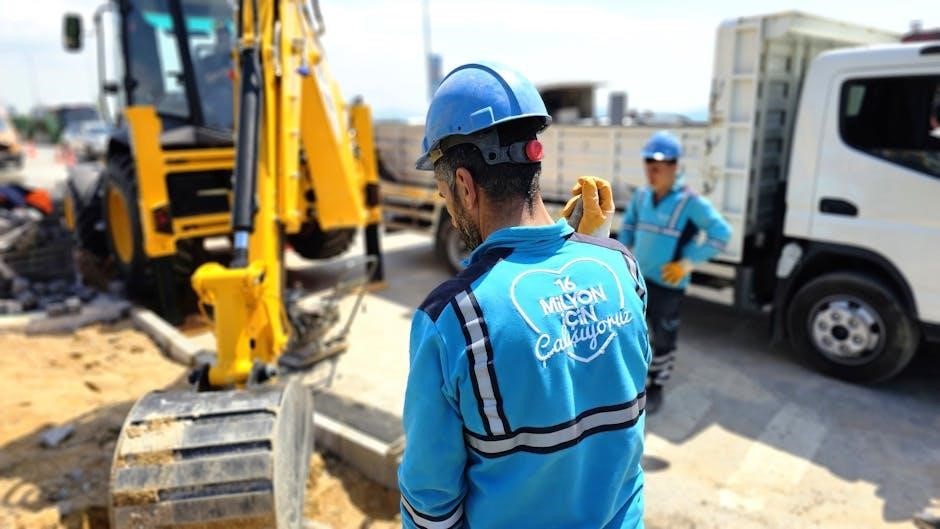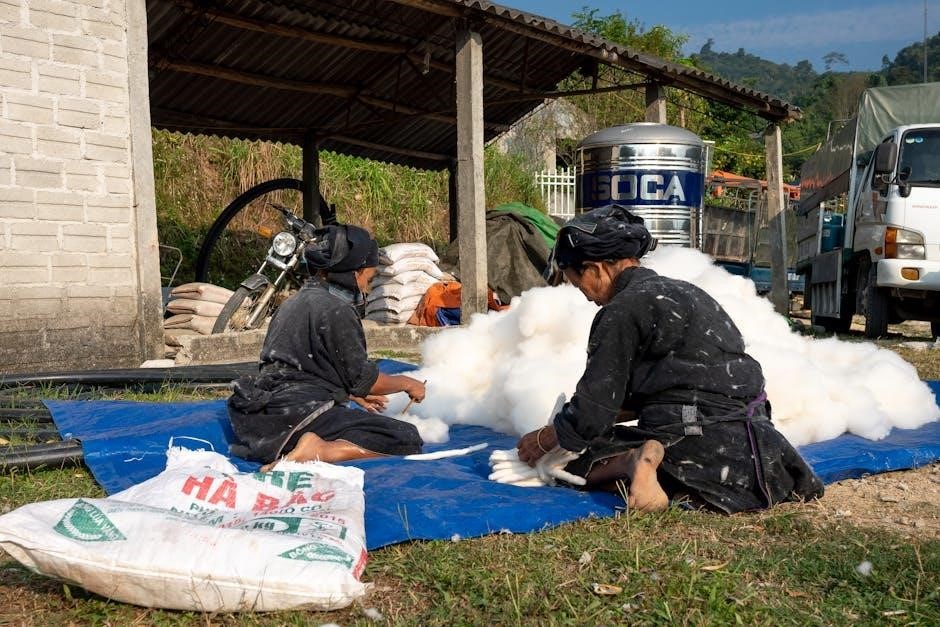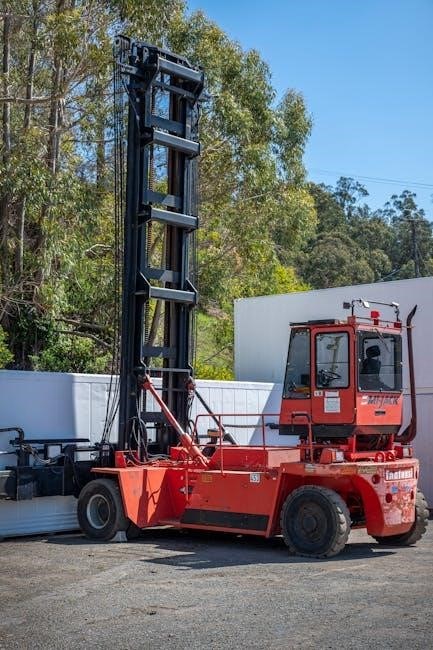Toyota forklift truck manuals are comprehensive guides providing essential information for safe operation‚ maintenance‚ and troubleshooting. They include detailed instructions‚ diagrams‚ and specifications to ensure optimal performance and longevity of equipment.
1.1 Overview of Toyota Forklift Truck Manuals
Toyota forklift truck manuals are essential resources for operators‚ technicians‚ and owners. They provide detailed instructions for the safe operation‚ maintenance‚ and repair of Toyota forklifts. These manuals cover model-specific information‚ including technical specifications‚ safety guidelines‚ and diagnostic procedures. They serve as a comprehensive guide to ensure optimal performance‚ longevity‚ and compliance with safety standards. By following the manual‚ users can identify potential issues early‚ perform routine maintenance‚ and troubleshoot common faults effectively. Adhering to the manual’s instructions helps maximize efficiency and safety in industrial operations.
1.2 Key Features of Toyota Forklift Manuals
Toyota forklift manuals are designed to provide clear‚ model-specific guidance. They include detailed service procedures‚ troubleshooting methods‚ and lubrication charts. These manuals also outline periodic maintenance schedules and parts replacement guidelines. Key features include step-by-step repair instructions‚ electrical diagrams‚ and component location maps. They emphasize safety protocols and operational best practices. The manuals are structured to help users identify and resolve issues efficiently. By following these guides‚ operators and technicians can ensure optimal performance‚ reduce downtime‚ and extend the lifespan of their equipment. They are indispensable for maintaining Toyota forklifts in peak condition.
1.3 Importance of Using Official Toyota Manuals
Using official Toyota forklift manuals ensures accuracy and reliability in maintenance and repair. They provide model-specific instructions‚ reducing the risk of errors. Official manuals include essential safety guidelines‚ troubleshooting steps‚ and compliance requirements. They help maintain equipment performance and longevity. Relying on unofficial sources can lead to incorrect procedures‚ potentially causing damage or safety hazards. Official manuals are updated with the latest technical specifications‚ ensuring operators stay informed. They are vital for diagnosing issues and performing repairs correctly. Adhering to these manuals helps prevent downtime and ensures compliance with industry standards‚ safeguarding both the equipment and operators.

Safety Guidelines in Toyota Forklift Manuals
Toyota forklift manuals emphasize critical safety protocols‚ including load capacity adherence‚ proper stabilization during operation‚ and emergency shutdown procedures to prevent accidents and ensure operator well-being.
2.1 General Safety Precautions
Toyota forklift manuals outline essential safety measures to ensure operator and workplace safety. These include pre-operation checks‚ load capacity adherence‚ and proper stabilization during operation. Operators are advised to wear personal protective equipment and maintain clear visibility; The manuals also emphasize the importance of securing loads properly and avoiding uneven or slippery surfaces. Additionally‚ they provide guidelines for safe handling of heavy components and emergency procedures‚ such as using wire ropes for hoisting and supporting vehicles with rigid stands during maintenance. Adhering to these precautions minimizes risks and ensures a safe working environment.
2.2 Operating Safety Tips
Toyota forklift manuals emphasize critical operating safety tips to enhance workplace safety. Operators are advised to maintain control accuracy‚ especially when handling heavy loads or working at heights. Smooth acceleration and deceleration are recommended to prevent load shifting. The manuals also stress the importance of proper load positioning and securing to avoid accidents. Operators should always maintain three points of contact when entering or exiting the forklift and ensure clear visibility by adjusting seats and mirrors. Additionally‚ regular checks of brakes‚ tires‚ and steering ensure safe operation‚ while adhering to load capacity guidelines prevents overloading and potential hazards.
2.3 Emergency Procedures
Toyota forklift manuals outline essential emergency procedures to ensure operator and workplace safety. In case of system failure or accident‚ operators should immediately stop the forklift‚ engage the brakes‚ and evacuate if necessary. For incidents involving heights‚ stabilizing devices should be used to prevent tipping. The manual also advises switching off the engine and isolating power sources during emergencies. Operators are instructed to contact trained professionals for assistance and avoid attempting repairs without proper authorization. Adhering to these procedures minimizes risks and ensures effective response to critical situations‚ aligning with Toyota’s commitment to safety and operational excellence.
Maintenance and Service Procedures
Toyota forklift manuals emphasize regular maintenance for optimal performance. They include lubrication schedules‚ fluid checks‚ and inspection timelines to ensure equipment longevity and operational efficiency.
3.1 Routine Maintenance Schedule
Toyota forklift manuals outline a detailed routine maintenance schedule to ensure optimal performance. This includes daily checks‚ weekly lubrication‚ and monthly inspections. Operators are advised to follow the lubrication chart and replace fluids as specified. The schedule also covers tire pressure checks‚ battery maintenance‚ and hydraulic system inspections. Adhering to these routines helps prevent breakdowns and extends equipment lifespan. The manual provides timelines and procedures for each task‚ ensuring compliance with safety and efficiency standards. Regular maintenance is crucial for maintaining operational reliability and safety in industrial environments.
3.2 Lubrication and Fluid Replacement
Toyota forklift manuals emphasize the importance of proper lubrication and fluid replacement to maintain equipment performance. The lubrication chart provides specific intervals for greasing moving parts and replacing hydraulic fluids. Operators must use genuine Toyota-approved lubricants to ensure compatibility and longevity. Fluid replacement schedules are detailed‚ including oil‚ coolant‚ and transmission fluid changes. Regular checks for leaks and contamination are also recommended. Adhering to these guidelines prevents wear and tear‚ ensuring smooth operation and extending the lifespan of the forklift. Proper fluid management is critical for maintaining hydraulic system efficiency and overall machine reliability.
3.3 Periodic Inspection Checklist
The Toyota forklift manual provides a detailed periodic inspection checklist to ensure equipment safety and efficiency. Operators should regularly check brakes‚ tires‚ hydraulic systems‚ and electrical components. The checklist includes verifying fluid levels‚ inspecting for leaks‚ and ensuring proper function of safety features. Lubrication points and fluid replacement intervals are outlined to maintain optimal performance. The manual also specifies inspection schedules based on operational hours or mileage. Adhering to this checklist helps prevent breakdowns‚ ensures compliance with safety standards‚ and extends the lifespan of the forklift. Regular inspections are crucial for maintaining reliability and operational efficiency.

Troubleshooting Common Issues

The Toyota forklift manual provides detailed troubleshooting guides to identify and resolve common faults. It covers diagnostic techniques‚ repair guidelines‚ and solutions for optimal performance and safety.
4.1 Identifying Common Faults
The Toyota forklift manual outlines common faults such as electrical malfunctions‚ hydraulic issues‚ and engine problems. It provides step-by-step guides to identify these faults through error codes‚ unusual noises‚ or performance declines. Operators are advised to review the troubleshooting section for detailed diagnostic procedures. Regular inspections and maintenance can prevent many of these issues. The manual also includes charts and diagrams to help technicians pinpoint problems quickly. By addressing faults early‚ operators can ensure safety‚ reduce downtime‚ and extend the lifespan of the forklift. Proper identification is the first step toward effective repairs and maintaining optimal functionality.
4.2 Diagnostic Techniques
Toyota forklift manuals provide detailed diagnostic techniques to identify and resolve issues efficiently. These include error code analysis‚ system performance checks‚ and visual inspections. Technicians can use the manual’s troubleshooting charts to trace problems to their source. Diagnostic tools‚ such as multimeters and hydraulic pressure testers‚ are recommended for precise evaluations. The manual also outlines step-by-step procedures for testing electrical circuits‚ hydraulic systems‚ and engine components. By following these methods‚ operators and technicians can quickly pinpoint faults‚ ensuring timely repairs and minimizing downtime. Regular use of these techniques helps maintain equipment reliability and performance.
4.3 Repair and Replacement Guidelines

Toyota forklift manuals provide clear repair and replacement guidelines to ensure safe and effective maintenance. They include step-by-step instructions for replacing worn or damaged parts‚ such as hydraulic components‚ engine parts‚ and electrical systems. The manuals emphasize the use of genuine Toyota parts for optimal performance and longevity. Detailed diagrams and torque specifications are provided to guide technicians through complex repairs. Safety protocols‚ such as proper lifting and support procedures‚ are highlighted to prevent accidents. By following these guidelines‚ operators can restore their forklifts to peak condition‚ minimizing downtime and extending equipment life. Regular replacements are crucial for maintaining reliability.
History of Toyota Forklift Trucks
The history of Toyota forklift trucks began in 1955 with the introduction of the Toyota LA model‚ marking the brand’s entry into material handling equipment. Since then‚ Toyota has continuously innovated‚ developing advanced forklift technologies that have set industry standards for reliability and performance. Today‚ Toyota remains a global leader in the production of high-quality forklift trucks‚ trusted by businesses worldwide for their durability and efficiency.
5.1 Early Models and Development
The development of Toyota forklift trucks began in 1955 with the introduction of the Toyota LA model‚ the first prototype in the company’s forklift lineup. This model laid the foundation for Toyota’s entry into the material handling industry‚ emphasizing durability and reliability. The LA model was designed to meet the growing demand for efficient warehouse operations‚ featuring basic yet robust mechanisms. Early manuals for these models focused on straightforward operation and maintenance procedures‚ reflecting the simplicity of the equipment at the time. These initial designs paved the way for Toyota’s reputation as a leader in forklift technology.
5.2 Evolution of Toyota Forklift Technology
Toyota forklift technology has evolved significantly over the years‚ driven by advancements in engineering and market demands. From the early models to modern electric and hybrid designs‚ Toyota has continuously innovated to improve efficiency and reduce environmental impact. The integration of automation and smart systems has enhanced operational precision‚ while the adoption of IoT technology enables real-time monitoring and data-driven decision-making. These advancements have solidified Toyota’s position as a leader in material handling‚ offering safer‚ more efficient‚ and environmentally friendly solutions for diverse industrial needs.
5.3 Milestones in Toyota Forklift History
Toyota’s forklift history began with the 1955 release of the LA model‚ its first prototype. The 1970s saw the introduction of electric forklifts‚ marking a shift toward eco-friendly solutions. In the 2000s‚ hybrid models were launched‚ combining efficiency and reduced emissions. Recent advancements include automation and IoT integration‚ enhancing operational efficiency. These milestones reflect Toyota’s commitment to innovation‚ sustainability‚ and meeting evolving industrial demands‚ solidifying its reputation as a pioneer in material handling technology.
Environmental Impact and Sustainability
Toyota forklifts emphasize eco-friendly designs‚ energy efficiency‚ and reduced emissions. They incorporate sustainable practices‚ promoting greener operations and minimizing environmental impact through advanced technology and responsible manufacturing processes.
6.1 Eco-Friendly Features of Toyota Forklifts
Toyota forklifts are designed with eco-friendly features to minimize environmental impact. Electric and hybrid models reduce emissions and energy consumption. Advanced power systems optimize efficiency‚ lowering operational costs. Sustainable manufacturing practices ensure eco-conscious production. These features align with global environmental standards‚ promoting greener warehouse operations and reducing carbon footprints. Toyota’s commitment to sustainability is evident in their innovative designs‚ making them a leader in environmentally responsible material handling solutions.
6.2 Energy Efficiency and Emissions Reduction
Toyota forklifts prioritize energy efficiency and emissions reduction through advanced technologies. Electric models eliminate emissions‚ while hybrid systems optimize fuel consumption. Regenerative braking captures energy‚ reducing battery depletion. Lightweight materials and streamlined designs enhance energy use. Toyota’s commitment to sustainability ensures lower operational costs and reduced environmental impact. These innovations align with global emissions standards‚ making Toyota forklifts a greener choice for modern logistics and material handling needs.
6.3 Sustainable Practices in Forklift Operations
Sustainable practices in Toyota forklift operations emphasize eco-friendly habits and resource optimization. Operators are trained to minimize energy consumption by avoiding excessive idling and using equipment efficiently. Regular maintenance ensures optimal performance‚ reducing waste and emissions. Toyota promotes the use of electric and hybrid models‚ which offer cleaner alternatives to traditional fuel-powered forklifts. Additionally‚ proper battery management and recycling programs contribute to environmental sustainability. By adopting these practices‚ businesses can reduce their carbon footprint while maintaining productivity‚ aligning with Toyota’s commitment to greener material handling solutions.
Training and Certification
Training and certification are crucial for Toyota forklift operators and technicians‚ ensuring safe‚ efficient‚ and compliant operations through structured programs that enhance performance and reduce workplace accidents.
7.1 Operator Training Requirements

Toyota forklift operator training requires comprehensive instruction on safety protocols‚ operational efficiency‚ and compliance with regulations. Operators must learn load handling‚ equipment inspection‚ and emergency procedures. Training includes both theoretical and practical sessions to ensure proficiency. Regular updates and assessments are essential to maintain certification and adapt to new technologies. Proper training reduces workplace accidents and enhances overall productivity‚ ensuring operators can handle Toyota forklifts safely and effectively in various environments.
7.2 Best Practices for Forklift Operators
Toyota forklift operators should always conduct pre-operation inspections‚ ensuring all components function properly. Adhering to load capacity limits and maintaining clear visibility are critical for safe operation. Operators must follow designated pathways‚ avoid sudden movements‚ and use safety features like seat belts. Proper handling techniques‚ such as lifting loads smoothly and stabilizing them before movement‚ are essential. Operators should also communicate clearly with coworkers and follow facility-specific safety protocols. Regular training updates and adherence to Toyota’s guidelines help minimize risks and ensure efficient‚ incident-free operations in various work environments.
7.3 Certification Programs for Technicians
Toyota offers structured certification programs for technicians‚ ensuring they master diagnostic‚ maintenance‚ and repair skills. These programs combine theoretical knowledge with hands-on training‚ focusing on Toyota-specific systems and technologies. Technicians learn to interpret manuals‚ perform complex repairs‚ and adhere to safety protocols. Certification involves rigorous assessments to verify expertise in areas like hydraulic systems‚ electrical diagnostics‚ and emission controls. Continuous education is encouraged to stay updated on new technologies and models‚ ensuring technicians maintain high standards of proficiency and compliance with industry regulations.

Parts and Accessories

Toyota forklift manuals detail genuine parts and accessories‚ ensuring safety and performance. They provide compatibility guidelines‚ maintenance schedules‚ and support for optimal equipment functionality and longevity.
8.1 Genuine vs. Aftermarket Parts
Toyota forklift manuals emphasize the importance of using genuine parts for optimal performance and safety. Genuine parts are designed to meet precise specifications‚ ensuring compatibility and reliability. Aftermarket parts may offer cost savings but often lack manufacturer warranties and quality assurance; Manuals highlight that genuine components are tested for durability and safety‚ reducing the risk of equipment failure. They also provide detailed part numbers and diagrams to help users identify authentic products. Using genuine parts ensures compliance with safety standards and maintains the forklift’s warranty‚ while aftermarket options may void guarantees and compromise performance.
8.2 Compatibility and Replacement Guidelines
Toyota forklift manuals provide detailed compatibility and replacement guidelines to ensure proper fitment and functionality. Each model-specific manual lists approved parts with corresponding numbers and diagrams. Users are advised to verify compatibility before installation to avoid malfunctions. The manuals emphasize the risks of using incompatible parts‚ which can lead to safety hazards and void warranties. They also outline step-by-step replacement procedures‚ including torque specifications and tool requirements. Adhering to these guidelines ensures optimal performance‚ safety‚ and compliance with manufacturer standards. Always consult the manual before performing any part replacement to guarantee accuracy and reliability.
8.3 Sources for Toyota Forklift Parts
Toyota forklift parts can be sourced from authorized dealers‚ official Toyota websites‚ and trusted distributors. The manuals often list approved suppliers to ensure genuine parts. Online marketplaces like Toyota’s official service portals offer direct access to components. Local dealerships provide personalized support and verification of part authenticity. Using genuine parts ensures compliance with safety standards and maintains equipment warranty. Counterfeit parts can compromise safety and performance‚ so verifying the source is crucial. Always refer to the manual for recommended suppliers and part numbers to guarantee compatibility and quality.

Technological Advancements
Toyota forklifts feature cutting-edge technologies like electric and hybrid models‚ automation systems‚ and IoT integration‚ enhancing efficiency‚ safety‚ and environmental performance in material handling operations.
9.1 Electric and Hybrid Forklift Models
Toyota offers advanced electric and hybrid forklift models designed for energy efficiency and reduced emissions. These models‚ such as the 7FBE series‚ combine powerful performance with eco-friendly technology. Hybrid options integrate electric motors with traditional power sources‚ minimizing environmental impact while maintaining productivity. The Traigo series‚ for instance‚ features lithium-ion battery technology for enhanced energy storage and longer operational hours. These innovations align with global sustainability goals‚ providing cost-effective and environmentally responsible solutions for modern material handling needs. Toyota’s commitment to green energy ensures these models meet stringent emissions standards while delivering reliable performance.
9.2 Automation and Smart Forklift Systems

Toyota’s automation and smart forklift systems represent a leap in material handling technology. The Traigo series‚ for example‚ integrates advanced automation features‚ enabling efficient warehouse operations. These systems utilize IoT connectivity‚ real-time data monitoring‚ and AI-driven insights to optimize workflows. Smart forklifts can autonomously navigate‚ detect obstacles‚ and adapt to dynamic environments‚ enhancing safety and productivity. Toyota’s automation solutions also include customizable software for seamless integration with existing warehouse management systems. By combining precision engineering with cutting-edge technology‚ Toyota’s smart forklifts set new standards for efficiency and innovation in the industry.
9.3 Integration of IoT in Forklift Operations
The integration of IoT in Toyota forklift operations enhances efficiency and safety through real-time monitoring and data-driven insights. IoT-enabled forklifts utilize sensors to track performance‚ location‚ and workload‚ ensuring optimal task allocation. Predictive maintenance is a key feature‚ as IoT systems analyze equipment health to prevent downtime. Operators receive alerts for potential issues‚ while managers gain visibility into fleet performance. IoT also supports automation‚ enabling forklifts to adapt to changing environments and improve accuracy in material handling. This technology not only streamlines operations but also lays the groundwork for future advancements in smart warehouse solutions.
Future Trends in Toyota Forklift Trucks
Toyota forklifts are embracing emerging technologies like AI‚ machine learning‚ and green energy solutions to enhance efficiency‚ sustainability‚ and operational safety‚ shaping the future of material handling.
10.1 Emerging Technologies in Material Handling
Emerging technologies in material handling include automation‚ smart systems‚ and IoT integration‚ enhancing efficiency and safety. Toyota is investing in autonomous forklifts and data-driven solutions to optimize warehouse operations. Electric and hybrid models are gaining traction‚ reducing emissions and operational costs. Advanced sensors and real-time monitoring systems improve predictive maintenance and reduce downtime. AI and machine learning are being applied to streamline tasks‚ such as route optimization and load management. These innovations are reshaping the industry‚ ensuring Toyota remains at the forefront of material handling technology.
10.2 AI and Machine Learning Applications
AI and machine learning are revolutionizing Toyota forklift operations by optimizing efficiency and safety. These technologies enable predictive maintenance‚ reducing downtime by anticipating equipment failures. Machine learning algorithms analyze operational data to improve task automation‚ such as route optimization and load management. AI-powered systems enhance safety by monitoring operator behavior and detecting potential hazards. Additionally‚ these technologies facilitate smarter inventory management and energy consumption optimization. Toyota is leveraging AI to create adaptive forklift systems that learn and improve over time‚ ensuring a safer and more efficient material handling experience.
10.3 Green Energy Solutions for Forklifts
Toyota is advancing green energy solutions for forklifts‚ focusing on eco-friendly technologies to reduce environmental impact. Electric and hybrid models are being developed to minimize emissions and energy consumption. These solutions include advanced battery systems‚ such as lithium-ion‚ which offer higher efficiency and longer lifespan. Additionally‚ Toyota is exploring alternative energy sources like hydrogen fuel cells for forklifts‚ aiming to achieve zero emissions. These innovations align with global sustainability goals‚ ensuring Toyota remains a leader in environmentally responsible material handling solutions while meeting customer demands for greener operations.